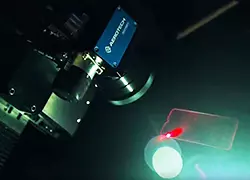What Is Laser Material Processing? | Meaning, Applications & Process Basics
What is laser material processing? Precision laser material processing is a broad term for a collection of advanced manufacturing techniques that use...
Work with our team to determine which products or systems are the best fit for your application.
Some Aerotech products are available for immediate order in North America through our partner Motion Plus.

A case study examining display production that optimizes quality and throughput – and lower total cost.
3 min read
 Bryan Germann
Jun 30, 2025 2:32:02 PM
Bryan Germann
Jun 30, 2025 2:32:02 PM
Precision laser material processing encompasses a wide array of techniques that have revolutionized modern manufacturing. The basic applications of laser in industry range from welding and drilling to surface texturing and marking. However, when it comes to prevalence and widespread industrial adoption, one application stands out. While processes like laser marking and welding are incredibly common, laser cutting is arguably the most ubiquitous and well-established laser processing method used in factories and job shops around the world.
This article will explore why laser cutting holds this title, while also looking at other key laser processes like drilling and machining to understand how these powerful technologies compare and where they are best applied.
The laser drilling process is a subtractive manufacturing technique that uses a focused laser beam to create holes in a material. It works by delivering one or more high-energy pulses of light to a specific point. This intense energy rapidly heats, melts and vaporizes the material. A jet of assist gas is often used to help eject the molten and vaporized material, resulting in a clean hole.
This process is incredibly fast and precise, capable of creating holes with diameters measured in micrometers. For many materials, a pulsed laser is the best choice for drilling operations. due to its ability to deliver high peak power that efficiently vaporizes material with minimal heat transfer to the surrounding area. This is critical for drilling dense patterns of microvias in electronics or fine cooling holes in aerospace components.
For many materials, a pulsed laser is the best choice for drilling operations.
The type of laser used in laser beam machining is chosen based on the material being processed and the specific application. The goal is to select a laser with a wavelength that the material absorbs efficiently. The most common types used in industrial settings include:
Fiber Lasers: Today, fiber lasers are the dominant choice for most metal machining applications, including cutting and welding. Their ~1 µm wavelength is well-absorbed by metals, and they offer excellent beam quality and high efficiency.
CO₂ Lasers: Historically the workhorse of the industry, CO₂ lasers are still widely used, particularly for cutting non-metals like plastics, wood and acrylics, as well as for processing thick-section steel.
Ultrafast Lasers: For the highest-precision micromachining, ultrafast lasers (picosecond and femtosecond) are used. They remove material through "cold" ablation, which minimizes heat damage and allows for the creation of exceptionally fine, high-quality features in almost any material.
While closely related, laser beam machining is a broader category, and laser cutting is a specific type of laser machining. Laser machining refers to any process that uses a laser to selectively remove material. This includes drilling, scribing, engraving and cutting.
Laser cutting specifically refers to the process of severing a part from a larger piece of material by tracing a continuous path. The laser cutting process step-by-step involves:
Piercing the material with an initial laser pulse.
Engaging an assist gas to begin ejecting molten material.
Moving the laser beam along a programmed vector path.
Continuously melting and ejecting material to create a through-cut, or kerf.
So, all laser cutting is a form of laser machining, but not all laser machining is laser cutting.
Like any manufacturing technology, laser machining comes with a distinct set of strengths and weaknesses. A full examination of laser beam machining advantages and disadvantages shows that its benefits are particularly powerful for high-precision and high-flexibility applications.
Advantages:
High Precision: Lasers can create extremely fine features with tolerances measured in micrometers.
No Tool Wear: As a non-contact process, there is no physical tool to wear out, ensuring consistent quality over time.
Flexibility: The process is software-driven, allowing for rapid changes between different designs without retooling.
Material Versatility: Lasers can process a vast range of materials, including metals, plastics, ceramics and composites.
Disadvantages:
Material Thickness Limitation: The effectiveness of laser machining can decrease with very thick materials.
High Initial Investment: Laser systems can have a higher upfront capital cost compared to some traditional machine tools.
Reflectivity Issues: Highly reflective materials can be challenging to process, although modern fiber lasers have significantly improved this capability.
What is laser material processing? Precision laser material processing is a broad term for a collection of advanced manufacturing techniques that use...
1 min read
How does laser processing work? Laser processing is a sophisticated manufacturing technique that uses a focused beam of light to precisely alter...
What Can You Cut with a Galvo Laser Scan Head? Galvanometer (galvo) laser scan heads are renowned for their incredible speed and precision, making...